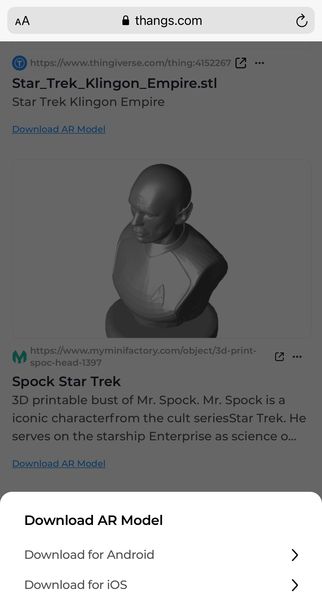
Thangs introduced an amazing new feature: augmented reality.
The rapidly-growing 3D model repository added a rather useful new feature: augmented reality, which allows you to visualize how a 3D model might appear in real life after printing.
Thangs 3D Models
The site now holds almost 1.5M 3D models, far more than many startup repositories, and placing it among the key sources for many seeking printable 3D models. While it holds its own 3D models, it mainly acts as a meta-site, referring you to 3D models stored on other repositories.

While some of the referring sites are well-known, like Thingiverse or MyMiniFactory, there are some questionable sites monitored by Thangs, such as archibaseplanet.com, where you’re flooded with advertisements and annoying popup messages. Here you can see a vase page on that site, where only TEN PERCENT of the page is the model and the rest is advertising. That’s not a good ratio, but the message here is to be cautious when clicking on Thangs links.
Augmented Reality 3D Models

Back to the AR announcement.
Thangs has added a special button to many of their 3D model entries, called “Download AR”. This is how you engage the AR feature, but it works only — and ssensibly — on mobile devices.
Once you hit the button, you’re presented with a screen showing the object, as seen here:

The next step is to touch the object, and the AR engine will start up. You’ll see a view of the surrounding area through your camera, but the 3D model will be imposed on the scene.
You can resize the 3D model by squeezing or expanding it with your fingers in the usual manner. It can be moved around in the scene by touching and dragging.
The AR system recognizes surfaces in the scenes and places the object properly where you select, and sizes the view appropriately.
Once placed, you can walk around the object and observe how it appears in that position, as if it were really there.
Here’s a short video from Thangs demonstrating how AR works:
But why do this at all? Why not just 3D print an object and you’re done?
The answer is that this AR feature allows you to test the size and appearance of a 3D model in a real-life scenario before you 3D print.
For example, you might be wondering what size a 3D model should be for it to fit nicely into a bookcase. With the AR feature you can simulate differently-sized 3D prints before printing, and thus potentially save considerable time and materials on wasted prints.
Another example might be to attempt to fit a part within another. Sure, this could be done with measurements, but in some cases that might be tricky if you don’t have access to the right kind of CAD tools for peculiar geometries.
Anything that can save print time is a good thing, in my mind.
I tested the AR feature on Apple Safari, and it worked immediately with no issues. Thangs said AR also works on Android, too, and each without requiring an app download.
If you’re curious whether an object with fit in a real-life scene, please give Thangs AR a test. It’s easy to use and surprisingly useful.
Via Thangs
